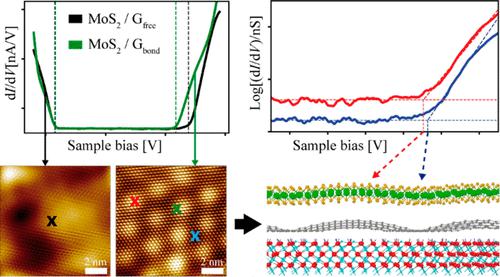当前位置:
X-MOL 学术
›
J. Phys. Chem. C
›
论文详情
Our official English website, www.x-mol.net, welcomes your
feedback! (Note: you will need to create a separate account there.)
The MoS2-Graphene-Sapphire Heterostructure: Influence of Substrate Properties on the MoS2 Band Structure
The Journal of Physical Chemistry C ( IF 3.3 ) Pub Date : 2023-05-29 , DOI: 10.1021/acs.jpcc.3c02503 Henrik Wördenweber 1, 2 , Annika Grundmann 3 , Zhaodong Wang 1, 4 , Susanne Hoffmann-Eifert 4 , Holger Kalisch 3 , Andrei Vescan 3 , Michael Heuken 3, 5 , Rainer Waser 1, 4, 6 , Silvia Karthäuser 1
The Journal of Physical Chemistry C ( IF 3.3 ) Pub Date : 2023-05-29 , DOI: 10.1021/acs.jpcc.3c02503 Henrik Wördenweber 1, 2 , Annika Grundmann 3 , Zhaodong Wang 1, 4 , Susanne Hoffmann-Eifert 4 , Holger Kalisch 3 , Andrei Vescan 3 , Michael Heuken 3, 5 , Rainer Waser 1, 4, 6 , Silvia Karthäuser 1
Affiliation

|
Van der Waals MoS2/graphene heterostructures are promising candidates for advanced electronics and optoelectronics beyond graphene. Herein, scanning probe methods and Raman spectroscopy were applied for analysis of the electronic and structural properties of monolayer (ML) and bilayer 2H-MoS2 deposited on single-layer graphene (SLG)-coated sapphire (S) substrates by means of an industrially scalable metal organic chemical vapor deposition process. The SLG/S substrate shows two regions with distinctly different morphology and varied interfacial coupling between SLG and S. ML MoS2 nanosheets grown on the almost free-standing graphene show no detectable interface coupling to the substrate, and a value of 2.23 eV for the MoS2 quasiparticle bandgap is determined. However, if the graphene is involved in hydrogen bonds to the hydroxylated sapphire surface, an increased MoS2/graphene interlayer coupling results, marked by a shift of the conduction band edge toward Fermi energy and a reduction of the ML MoS2 quasiparticle bandgap to 1.98 eV. The surface topography reveals a buckle structure of ML MoS2 in conformity with SLG that is used to determine the dependence of the ML MoS2 bandgap on the interfacial spacing of this heterostructure. In addition, an in-gap acceptor state about 0.9 eV above the valence band minimum of MoS2 has been observed on locally elevated positions on both SLG/S regions, which is attributed to local bending strain in the grown MoS2 nanosheets. These fundamental insights reveal the impact of the underlying substrate on the topography and the band alignment of the ML MoS2/SLG heterostructure and provide the possibility for engineering the quasiparticle bandgap of ML MoS2/SLG grown on controlled substrates that may impact the performance of electronic and optoelectronic devices therewith.
中文翻译:

MoS2-石墨烯-蓝宝石异质结构:衬底特性对 MoS2 能带结构的影响
范德瓦尔斯 MoS 2 /石墨烯异质结构是超越石墨烯的先进电子学和光电子学的有前途的候选者。在此,应用扫描探针方法和拉曼光谱分析单层 (ML) 和双层 2H-MoS 2的电子和结构特性,通过工业方法沉积在单层石墨烯 (SLG) 涂层蓝宝石 (S) 基板上可扩展的金属有机化学气相沉积工艺。SLG/S 基板显示出两个具有明显不同形态的区域以及 SLG 和 S 之间不同的界面耦合。在几乎独立的石墨烯上生长的 ML MoS 2纳米片显示与基板没有可检测的界面耦合,并且值为 2.23 eV二硫化钼准粒子带隙被确定。然而,如果石墨烯与羟基化蓝宝石表面形成氢键,则会导致 MoS 2 /石墨烯层间耦合增加,其标志是导带边缘向费米能级移动,ML MoS 2准粒子带隙减小至 1.98电子伏特。表面形貌揭示了符合 SLG 的 ML MoS 2带扣结构,用于确定 ML MoS 2带隙对该异质结构界面间距的依赖性。此外,间隙受主态比 MoS 2的价带最小值高约 0.9 eV已在两个 SLG/S 区域的局部升高位置观察到,这归因于生长的 MoS 2纳米片中的局部弯曲应变。这些基本见解揭示了底层衬底对 ML MoS 2 /SLG 异质结构的形貌和能带排列的影响,并为设计在受控衬底上生长的 ML MoS 2 /SLG的准粒子带隙提供了可能性,这可能会影响性能电子和光电设备。
更新日期:2023-05-29
中文翻译:

MoS2-石墨烯-蓝宝石异质结构:衬底特性对 MoS2 能带结构的影响
范德瓦尔斯 MoS 2 /石墨烯异质结构是超越石墨烯的先进电子学和光电子学的有前途的候选者。在此,应用扫描探针方法和拉曼光谱分析单层 (ML) 和双层 2H-MoS 2的电子和结构特性,通过工业方法沉积在单层石墨烯 (SLG) 涂层蓝宝石 (S) 基板上可扩展的金属有机化学气相沉积工艺。SLG/S 基板显示出两个具有明显不同形态的区域以及 SLG 和 S 之间不同的界面耦合。在几乎独立的石墨烯上生长的 ML MoS 2纳米片显示与基板没有可检测的界面耦合,并且值为 2.23 eV二硫化钼准粒子带隙被确定。然而,如果石墨烯与羟基化蓝宝石表面形成氢键,则会导致 MoS 2 /石墨烯层间耦合增加,其标志是导带边缘向费米能级移动,ML MoS 2准粒子带隙减小至 1.98电子伏特。表面形貌揭示了符合 SLG 的 ML MoS 2带扣结构,用于确定 ML MoS 2带隙对该异质结构界面间距的依赖性。此外,间隙受主态比 MoS 2的价带最小值高约 0.9 eV已在两个 SLG/S 区域的局部升高位置观察到,这归因于生长的 MoS 2纳米片中的局部弯曲应变。这些基本见解揭示了底层衬底对 ML MoS 2 /SLG 异质结构的形貌和能带排列的影响,并为设计在受控衬底上生长的 ML MoS 2 /SLG的准粒子带隙提供了可能性,这可能会影响性能电子和光电设备。

































 京公网安备 11010802027423号
京公网安备 11010802027423号